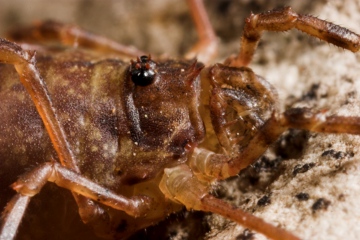Summary for Lophopilio palpinalis (Opiliones)
previous species | next species
National Distribution
Terms of Use. Double-click on map to go to region

Explore Regional Distribution
Please log on and add a note on this species
About this species
Recorded altitude range8m to 460m
Species text
DistributionLophopilio palpinalis is widespread in Britain but may be under-recorded because of its secretive habits and small size. It was first recorded as a British species by Meade (1855) from a specimen collected in north Wales. It extends to the Hebrides (all pre-1980 records) and the north coast of Scotland, but not Orkney or Shetland.
It occurs across Europe: France, the Netherlands, Belgium, Germany, Denmark, southern Sweden, Latvia to the east of the Crimea, and south into Bulgaria, Montenegro, Bosnia-Herzegovina.
Habitat and ecology
Lophopilio palpinalis is a small, ground-layer species of damp woodland, wetlands, hedgerows and gardens but it can also occur in more open habitats such as grassland and heathland. In the Netherlands it occurs in dunes, presumably finding a sufficiently moist microclimate there. It is usually found in litter, moss, rank grass etc. It has been collected at altitudes up to 460m in Britain and up to 1700m in the Alps (Martens 1978).
This is a quite late-maturing species, becoming adult from July, peaking in November and persisting through to January. The juveniles are found from around May until October and the eggs are laid in late summer/autumn but do not hatch until spring.
The most notable feature of this species is the structure of the palps; with their relatively huge downward pointing tubercles and inward facing outgrowths, together with a forward-pointing trident, they form a formidable cage around the mouthparts. This is perhaps similar in function to the mandibles of the ground-beetle Leistus. This structure undoubtedly assists in prey capture and indeed their recorded invertebrate food includes hard-to-catch springtails as well as homopteran bugs, barkflies, diptera, myriapods, spiders, earthworms and gastropods. It has also been reported feeding on mushroom juices.
These charismatic animals are ideal for studying adaptations for prey capture.
Status
Widespread
Text based on: Hillyard, P. D. 2005. Harvestmen: keys and notes for the identification of British species. Synopses of the British Fauna 4 (3rd edn) Field Studies Council, Shrewsbury.
References
Martens, J. 1978. Spinnentiere, Arachnida: Weberknechte, Opiliones. Die Tierwelt Deutschlands 64: 1-464. Fischer Verlag, Jena.
Meade R. H. 1855. XXXV. Monograph on the British species of Phalangiidae or Harvestmen. Annals & Magazine of Natural History 2nd Series 15(90): 393-416
References
Adult Season
Habitats
background methodology
Recorded management for locations with Lophopilio palpinalis
Recorded substrate and hydrology for locations with Lophopilio palpinalis
Images
please log on and upload a new image for this speciesSee also A-Z Species Index - A-Z Picture Index - previous species | next species


